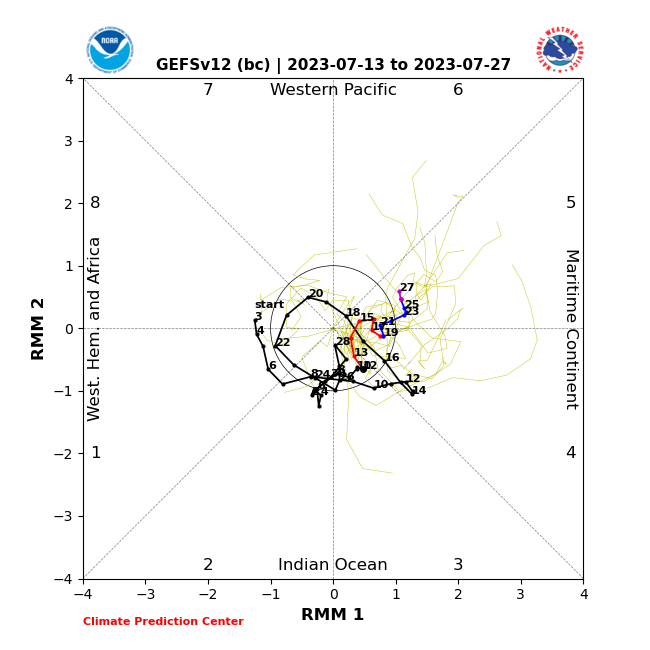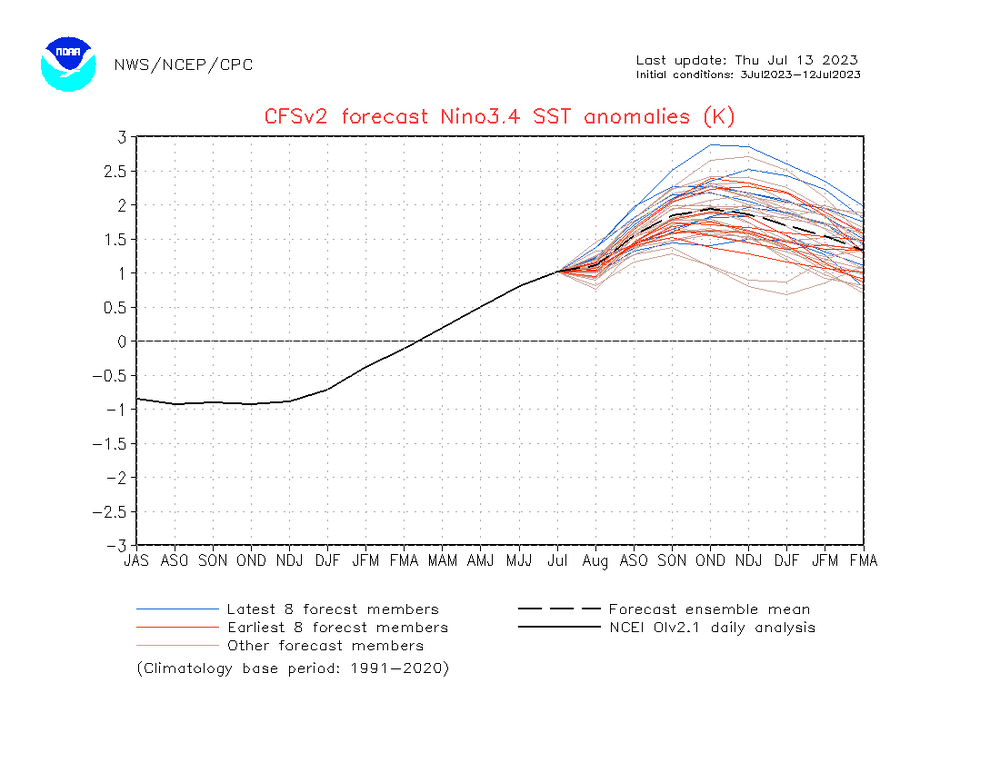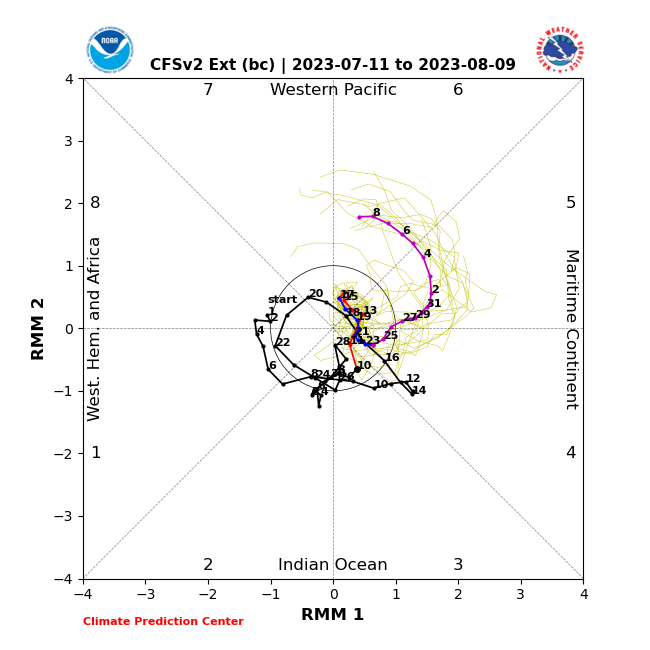
GaWx
Members-
Posts
17,048 -
Joined
Content Type
Profiles
Blogs
Forums
American Weather
Media Demo
Store
Gallery
Everything posted by GaWx
-
Just like that, the wildly varying bc GEFS is today back to being totally within the circle. The less accurate bc CFS further out in forecast time though had a slight increase in the amplitude in phases 5-6 with max in phase 6 back up to ~1.8 amp (on Aug 9) vs ~1.6 yesterday.
-
BULLETIN Subtropical Storm Don Advisory Number 1 NWS National Hurricane Center Miami FL AL052023 500 AM AST Fri Jul 14 2023 ...SUBTROPICAL STORM DON FORMS OVER THE CENTRAL ATLANTIC... SUMMARY OF 500 AM AST...0900 UTC...INFORMATION ---------------------------------------------- LOCATION...32.9N 46.8W ABOUT 1165 MI...1875 KM WSW OF THE AZORES MAXIMUM SUSTAINED WINDS...50 MPH...85 KM/H PRESENT MOVEMENT...N OR 360 DEGREES AT 6 MPH...9 KM/H MINIMUM CENTRAL PRESSURE...1002 MB...29.59 INCHES FORECAST POSITIONS AND MAX WINDS INIT 14/0900Z 32.9N 46.8W 45 KT 50 MPH 12H 14/1800Z 33.5N 47.0W 45 KT 50 MPH 24H 15/0600Z 34.9N 47.3W 45 KT 50 MPH 36H 15/1800Z 36.4N 47.8W 45 KT 50 MPH 48H 16/0600Z 37.6N 47.8W 40 KT 45 MPH 60H 16/1800Z 38.4N 47.1W 40 KT 45 MPH 72H 17/0600Z 38.5N 44.9W 35 KT 40 MPH 96H 18/0600Z 35.9N 40.7W 35 KT 40 MPH 120H 19/0600Z 33.4N 38.5W 40 KT 45 MPH $$ Forecaster Cangialosi
-
Here comes STS Don very soon! Tropical Weather Outlook NWS National Hurricane Center Miami FL 200 AM EDT Fri Jul 14 2023 For the North Atlantic...Caribbean Sea and the Gulf of Mexico: 1. Central Atlantic (AL94): Satellite data indicate that the area of low pressure located about 1000 miles west-southwest of the Azores is producing a large area of gale-force winds on its east side. In addition, the thunderstorm activity has remained organized near the center during the past several hours. If current trends continue, advisories could be initiated on a subtropical storm later this morning while it meanders over the central Atlantic. By the weekend, the low should turn northward, bringing the system over cooler waters and into a drier airmass potentially limiting further development. Additional information on this system, including storm warnings, can be found in High Seas Forecasts, issued by the National Weather Service. * Formation chance through 48 hours...high...90 percent. * Formation chance through 7 days...high...90 percent.
-
94L is more organized now. Chances up to 70%/70%. Should be a NS pretty soon.
-
It is now more than in the recent past. But still not all that much and not as much as is the case for crude oil. US NG prices were pretty rarely affected much by wars and other geopolitical events/issues back when we were hardly exporting NG. The medium range US wx forecast, especially in the E US in winter and secondarily in summer, was as big a factor as any. However, once exports increased significantly, geopolitical factors (especially in Europe due to the demand for NG exports to there being heavily influenced by those factors) started to have a more significant influence on prices on certain days. This was especially the case early in the Russia/Ukraine war. But US wx is still a huge factor and a bigger factor than geopolitical on most days. Compared to early in the war, geopolitical has actually lessened its influence on prices overall at least for now.
-
Today CPC said these were the approximate chances for the upcoming El Niño peak late this year: -super 20% -strong 32% -moderate 30% -weak 18% I see hardly any chance for a weak peak. That would require it to be peaking about now. Only 1953 peaked this early of the ~50 El Niño events since the mid 1800s. I'll call it a 1% chance. I have strong at ~50%, moderate at ~25%, and super at ~25% as of now although it is ever changing. https://www.cpc.ncep.noaa.gov/products/analysis_monitoring/enso_advisory/strengths/index.php
-
Thank you. Based on this graph, I'm estimating that ERA5 peaked at 17.08-17.09C, which is close to what I expected based on the CFSR peak of 17.23C (July 6th) since ERA5 is often 0.1 to 0.15 cooler than CFSR.
-
@bdgwx @chubbs and others, Did any of you see what the ERA5/Copernicus peaked at in early July? I'd like to compare it to the CFSR peak. I'd be shocked if it weren't slightly cooler as ERA5 generally runs slightly cooler than CFSR (~~0.1 C cooler recently).
-
And the CFS progged MJO amplitude continues to slowly weaken with it now only ~1.6 vs low 2 range just 3 days ago. I would like to note that the bc GEFS mean has been swinging pretty wildly from day to day. Just two days ago, it headed to right on the circle in phase 3. Today it has it back to a little outside the circle in phase 5, similar to 3 days ago! Also, folks should note the very large variance between members. That along with the big swings on the mean from day to day tell me that late July is not an easy forecast for GEFS and that more wild daily swings of the mean are quite possible:
-
I just looked at the latest CFS averaged out over the last 10 days (40 members). It surprisingly shows a significant warmer shift for the peak of the mean ONI from ~+1.75 on what your quoted post shows for the 6/25-7/4 run average to what it shows now, ~+1.97. Looking at the 8 blue lines (runs from the last 48 hours), 6 of them reach or exceed +2.0 for the peak. In contrast, only two blue reached +2.0 on both the 7/4 and 6/24 runs and none on the 6/14 run. Nearly half of the 40 members on this newest run reach or exceed +2.0 vs only a handful as you said as of eight days ago. It is possible that this is just a temporary blip and that the mean could easily trend back cooler over the next 10 days or so. Also, how accurate the CFS is in general is in question. But regardless, I'm looking at the latest CFS trend (vs 8 days ago) and it is warmer. Any thoughts from you or others on this warmer shift? Note that this isn't bc and thus should be adjusted for a bc, but I'm looking at the trend vs the non-bc graph as of 8 days ago (apples to apples):
-
So, 2023 is essentially flat vs the 2007-2022 average as of July 12th.
-
The official Key West buoy itself has been showing SSTs in low 90s for many days with ~2F diurnal range. Low 90s SSTs jibe well with recent Key West mean air temps just under 90 since the sea is often slightly warmer. The Key West air temp low this morning was only down to 87, which if it holds up til midnight would tie the record high low for any day back to 1873! https://tidesandcurrents.noaa.gov/stationhome.html?id=8724580 The buoy with ~97 SSTs the last few days is not that close to Key West. It is actually Johnson Key, which is 65 miles NE of Key West (not near the main Keys Highway 1 strip) and just S of the SW tip of the peninsula. The reason they've been so much higher than Key West is the very shallow water of a mere swimming pool type depth of ~5'. Due to this shallowness, the SST diurnal range has been 7+ F. The 97s occurred late afternoons/early evenings just after most of the day's solar heating has done its thing on the very shallow water. What many don't realize is that the AM SST lows have been 89-90 F there. So, the mean SST has been ~93-93.5 F, which is pretty close to Key West's mean SST of ~92. So, I do believe the 97 SST readings there have likely been pretty close to reality and thus most likely it isn't a "bad" station per se. However, it is admittedly deceptive due to being so shallow and having such a wide diurnal range: https://www.ndbc.noaa.gov/station_page.php?station=jkyf1 ------------------- *Edit: The 87 at Key West land station held on as the low for July 12th, which ties the record high low for any date back to 1873! Also, the mean temp of 90.5 turns out to be the hottest mean of any day back to 1873! The old record was 90.0, which was set on 8/4/2007. Marathon land station tied its alltime hottest mean of any on record, 92.0. The only other day on record with a mean this hot was 6/8/2019. This was the 32nd day this year and 8th day this month to date that Marathon beat or tied the daily record warm mean! Records go back to 1950.
-
There's still so signal for a strong MJO amplitude for 2+ weeks per GEFS/EPS and other non-CFS models. Also, the CFS, the only model with a hint of a possible strong MJO late month, has another slight reduction in its phase 5-6 amp after 2 weeks vs yesterday with amp ~1.75-1.8. Two days ago it was progging low 2s.
-
Now at 40%/50% for ST or tropical dep or storm. So, only a slight increase over the last 36 hours.
-
Ring of fire pattern offering some relief for SE US?
-
It got just about that insanely hot there today, too, (96.3 at 4PM) but the SST sensor suddenly went out. It was rising at the time. Yesterday's 96.8 was at 5PM. The water there is apparently quite shallow as one would expect with it so hot. The diurnal range was 7.3F yesterday and similar today with the wide range due to shallowness.
-
Maybe from CFS huggers even though the CFS is quite a bit inferior to GEFS/EPS. The CFS remains on its own with a significant MJO amplitude into phases 5 and 6 though not starting for two weeks and actually is slightly weaker vs yesterday's 2+ amp. I'm looking for it to correct further toward weaker amp on future runs: *Edit: keep in mind that CFS goes out further than GEFS/EPS and it's the further out in time and much more unreliable portion that goes well outside the circle. However, neither GEFS nor EPS suggests a strong move into phases 5-6 as of the ends of their runs as of now.
-
Check this out. Today's GEFS (bc) never gets out of the circle through the end of today's run (7/25). Today's stops moving up the diagram ~7/18 and then turns downward to end up on 7/25 on the circle headed toward phase 3 of all things compared to going outside the circle barely into phase 5 in yesterday's run as of 7/24! So, GEFS is signaling more than normal uncertainty late in the runs with this big change and still suggests no strong MJO being likely anytime soon:
-
Through July 11th, the July MTD OISST in 3.4 is still averaging only +1.0 with the implied ERSST likely close to only +0.9 to +0.95. These continue to be quite underwhelming when considering the BoM full July progs of +1.8 on the prior run and even the +1.5 of the current run. Major too warm bust coming.
-
RECORD EVENT REPORT NATIONAL WEATHER SERVICE KEY WEST FL 0136 AM EDT TUE JUL 11 2023 ...RECORD HIGH TEMPERATURE AND RECORD WARM LOW SET AT MARATHON TODAY... TODAY'S HIGH AT THE FLORIDA KEYS MARATHON INTERNATIONAL AIRPORT REACHED 97 DEGREES FAHRENHEIT, SETTING A NEW DAILY HIGH TEMPERATURE RECORD. THE PREVIOUS MOST RECENT RECORD WAS 94 DEGREES, SET IN 2020. TODAY'S LOW AT THE FLORIDA KEYS MARATHON INTERNATIONAL AIRPORT ONLY FELL TO 85 DEGREES FAHRENHEIT, SETTING A NEW DAILY WARM LOW TEMPERATURE RECORD. THE PREVIOUS RECORD WAS 84, SET IN 2009. TEMPERATURE RECORDS AT MARATHON DATE BACK TO 1950. ---------------- RECORD EVENT REPORT NATIONAL WEATHER SERVICE KEY WEST FL 140 AM EDT TUE JUL 11 2023 ..RECORD WARM LOW SET AT KEY WEST YESTERDAY'S LOW TEMPERATURE AT THE KEY WEST INTERNATIONAL AIRPORT WAS 86 DEGREES FAHRENHEIT, SETTING A NEW DAILY WARM LOW TEMPERATURE RECORD. THE PREVIOUS RECORD WAS 85, SET IN 2007. TEMPERATURE RECORDS AT KEY WEST DATE BACK TO 1872.
-
I've noticed that sometimes the EPS is too weak on the right half of the graph and that the higher amp of the GEFS is often closer in these cases. However, even the bc GEFS mean is only barely outside the circle and hardly moving in phase 5. So, I agree there's no model consensus indication of a strong MJO phase for at least two weeks. The only model with something more is the CFS (bc), with a pretty strong (amp >2) move to phases 5 and then 6 very late July into early August. But it's the inferior CFS and it's on its own.
-
Now it is up to 40% in the latest TWO. Per my recollection of recent years, either the NHC tends to underplay these subtropical lows regarding subtropical or tropical genesis in the TWO percent chances and/or they tend to "over-perform". Thus, considering this, being that about all models for several runs have had a pretty strong low forming within a few days, being that SSTs are near a warm enough 26C, and with pro-met "57" posting at another location going very bullish on ST or TCG, I'm going with a much higher chance than the NHC's 40% chance for a STD or TD to form from this. I think the NHC is playing catch-up as they had no chance within 7 days mentioned as recently as Saturday night.
-
Nino 3.4 rose 0.1 back to +1.0 as I had expected per OISST in today's weekly release, which is for the average of last week. But OISST has stalled again near +1.0 as of yesterday's daily. And keep in mind that ERSST, which ONI is based on, has recently been running 0.1+ cooler than OISST. Nino 3 and 4 also rose 0.1. But the most warming was in 1+2, which warmed 0.4 to +3.3, the warmest since 1998! The 100W-180W OHC actually fell a little vs the prior week. It had been near +1.35, but fell back to ~+1.20. That just about eliminates any chance for the overall July 3.4 to reach near the most recent BoM's +1.5.
-
Good luck to you! But even if he turns out to be "right", any one location can obviously still be hit very hard. For example, he didn't say that the one major hurricane that he's forecasting won't hit land as a hurricane, possibly even as a MH. Also, any of the other four other hurricanes he's forecasting could be quite rough somewhere if they make landfall. So, always being prepared for the worst case is wise.
-
7/9/23 updated tropical seasonal outlook from meteorologist Larry Cosgrove: "Despite what you may have heard, the potential for serious tropical cyclone development is decreasing. Low-latitude westerlies in the Atlantic Basin have still not lifted out, and with each passing day the chance for an extended "window" of favorable heat ridge positioning decreases. Another factor that is influencing the lack of convective production outside of Africa (despite an active ITCZ) is tremendous amounts of Saharan dust, concurrent with very low dewpoints and high temperatures. Warm waters in the Major Development Region do not alter or break the wind patterns associated with extreme warmth of the 1.2 ENSO sector. At some point the giant ridge complex (which will reach its apex in the last week of July), will weaken and some easterlies will set up from western Africa. But we are running out of time for that synoptic event to happen! Because at some point in late August the flow signatures will reset to west/southwest, shearing thunderstorm tops apart. For now I will keep my forecast total of 13 named storms, 5 hurricanes, and one major cyclone intact. But do not be surprised if a revision is announced."





